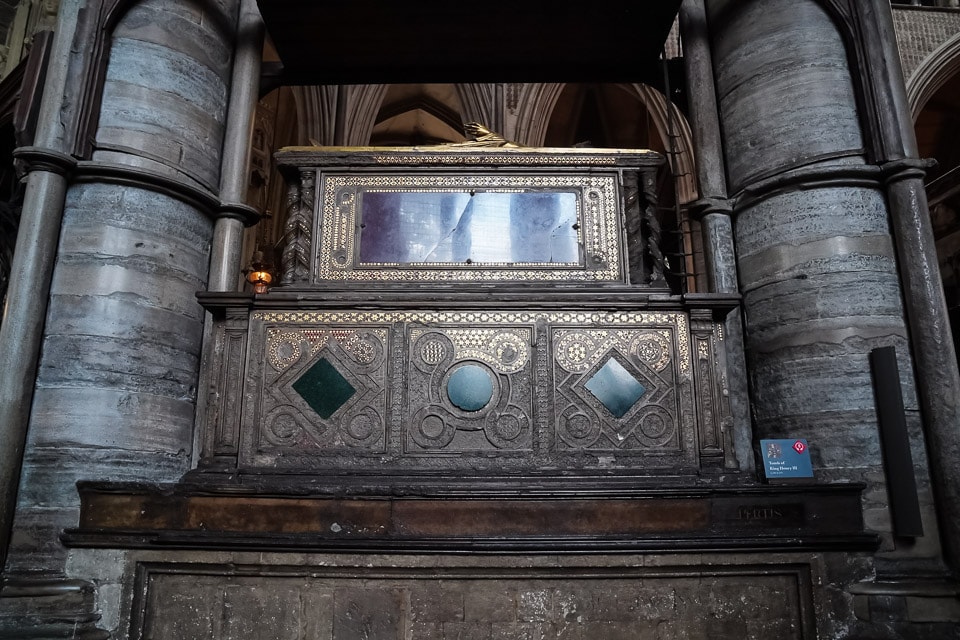Westminster Abbey Royal Tombs- The Royals and Monarchs Buried in Westminster Abbey
Purchases made through links earn us a small commission, at no extra cost to you.
Westminster Abbey has been closely connected to royalty for centuries, being used as a place of coronation, royal funerals, and burials.
Of the 3,000+ burials in Westminster Abbey, many are monarchs, consorts, princes, princesses, and other royal relatives. By visiting the royal tombs in Westminster Abbey, you can get a glimpse into the lives and deaths of the regal figures who helped shape British history.
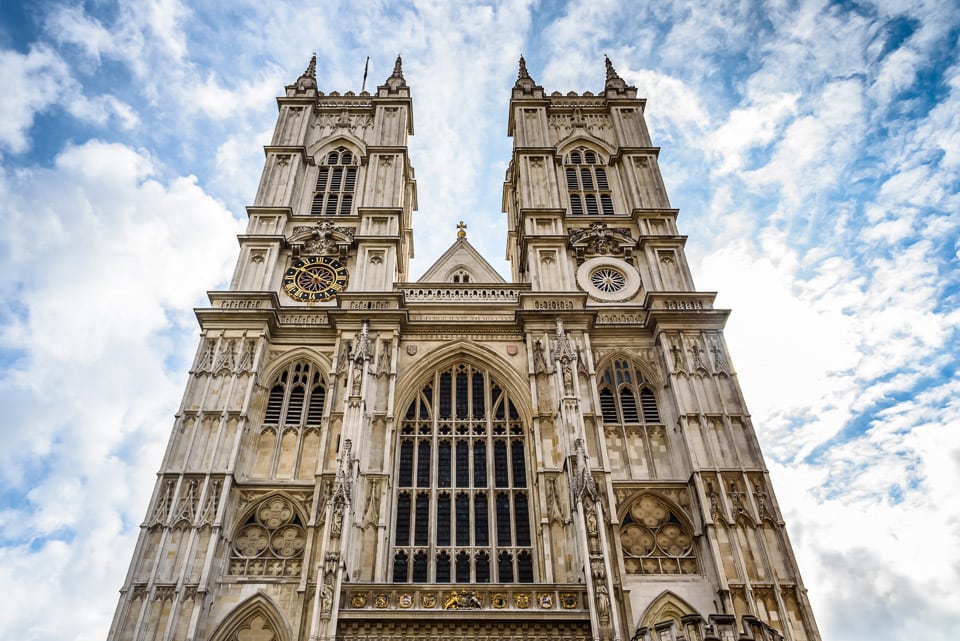
In This Post
Royal Tombs in Westminster Abbey
The royal tombs in Westminster Abbey range from shrines and grand memorials to simple chests and underground vaults. Most of the royal tombs are located in St. Edward’s Chapel and the stunning Lady Chapel. Some tombs are marked with large memorials, some with simple floor stones, and others aren’t marked at all.
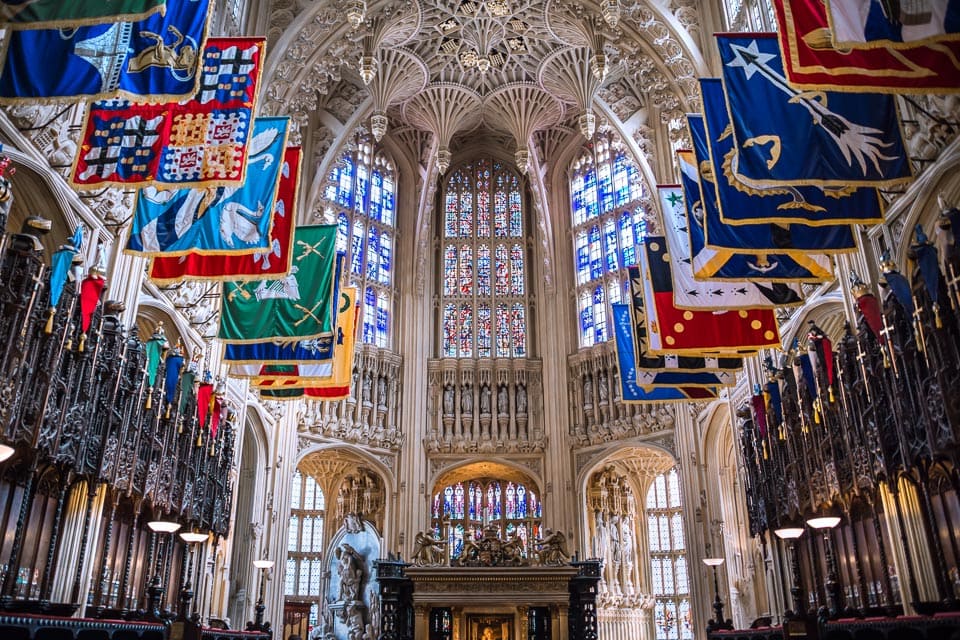
Monarchs Buried in Westminster Abbey
Starting with Edward the Confessor in 1066 until George II in 1760, most kings and queens of England have been buried at Westminster Abbey, with a few exceptions.
In total, there are 30 kings and queens buried in Westminster Abbey- 13 kings, 4 queens regnant, 11 queens consort, and 2 other queens.
Here are some consorts and monarchs buried in Westminster Abbey, with a brief biography and description of their tomb or grave.
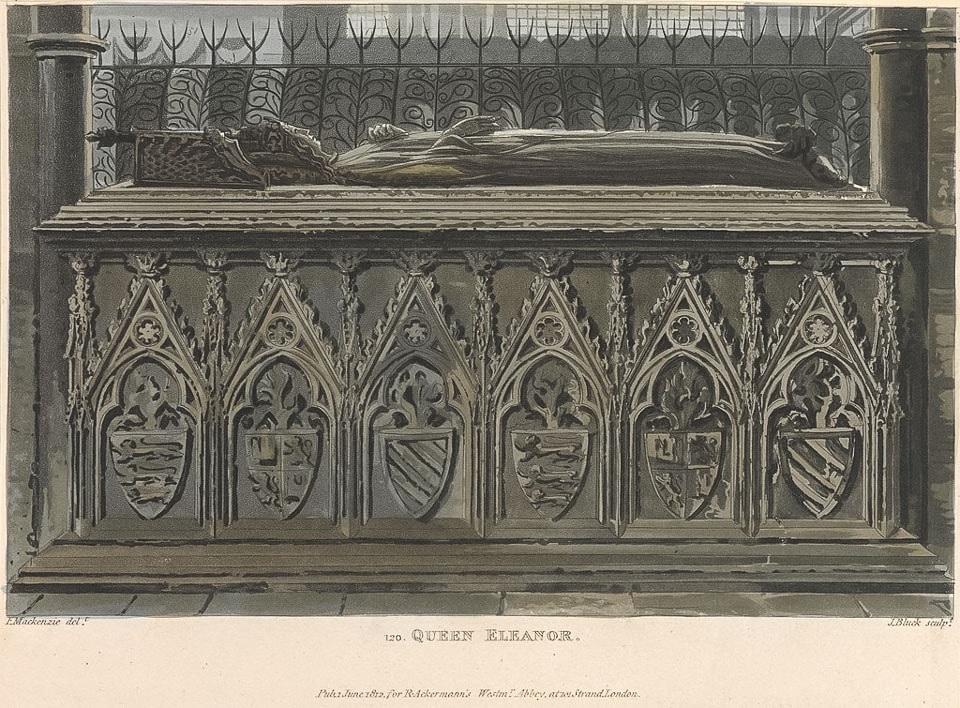
King Edward the Confessor and Queen Edith
Burial: St. Edward’s Chapel
Edward the Confessor’s reign as king began in 1042 and lasted until his death in 1066. Although he wasn’t necessarily considered a successful king, he was religious and endearing. In 1161, about a century after his death, he was officially canonized as Saint and Confessor by Pope Alexander III.
The tomb of Edward the Confessor is located in a specially-made shrine behind the High Altar in St. Edward’s Chapel. The shrine is made out of stone and Purbeck marble and features a tiered wooden canopy. It is decorated with mosaics but the jewels that once adorned the shrine were stolen long ago.
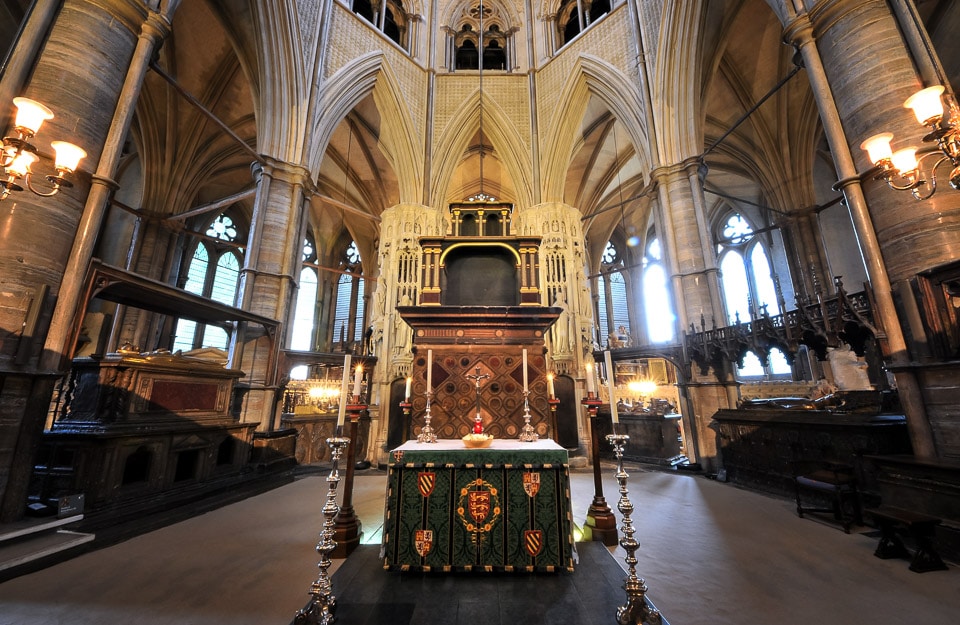
Edward’s wife Edith, a queen consort, was buried on the left side of Edward’s shrine but her grave is unmarked.
King Henry III
Burial: St. Edward’s Chapel
As king, Henry III had one of the longest reigns in English history. One of his greatest contributions was having Westminster Abbey rebuilt into the lavish Gothic structure we see today, but unfortunately, he died in 1272 long before it was completed.
Henry III was buried in Westminster Abbey near Edward the Confessor’s shrine in St. Edward’s Chapel. His large tomb is made out of Purbeck marble with slabs of green and purple porphyry. It is decorated with gilded mosaics and covered by a wooden canopy.
Laying on the top of the tomb is a gilt bronze effigy of Henry III dressed in a crown and robe. You can see small holes where jewels once were. His shoes and the pillows his head rests on are embellished with the lions of England. At one time the effigy was holding two sceptres, but those have disappeared.
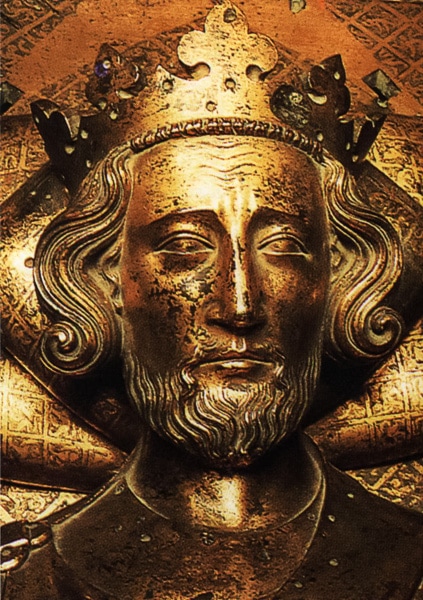
King Edward I and Queen Eleanor of Castile
Burial: St. Edward’s Chapel (South Ambulatory)
Edward I succeeded the throne from his father Henry III and reigned as King of England from 1272 until 1307. He is known for reforming common law, establishing Parliament, and conquering Wales.
Edward I died at age 68 of dysentery at Burgh by Sands in Cumberland and his body was brought to Westminster Abbey for burial. Unlike other royal tombs in Westminster Abbey, Edward I’s has no effigy or decorations- it’s a plain grey marble chest. There is however a faint inscription from the 16th century that translates to: Edward the First, Hammer of the Scots. Keep Troth.
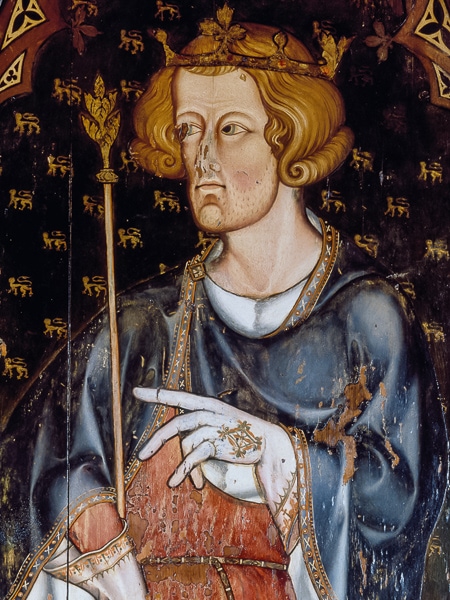
Edward I’s queen, Eleanor of Castile, has a more regal marble chest tomb. On top is a gilt bronze effigy of her wearing a crown and holding the string of her cloak in one hand, a pose that resembles the image on her seal. The side of the tomb is decorated with carvings and the slab and pillows she rests on are covered with emblems of castles and lions. There’s also a carved iron grille on the ambulatory side of the tomb and a wooden canopy.
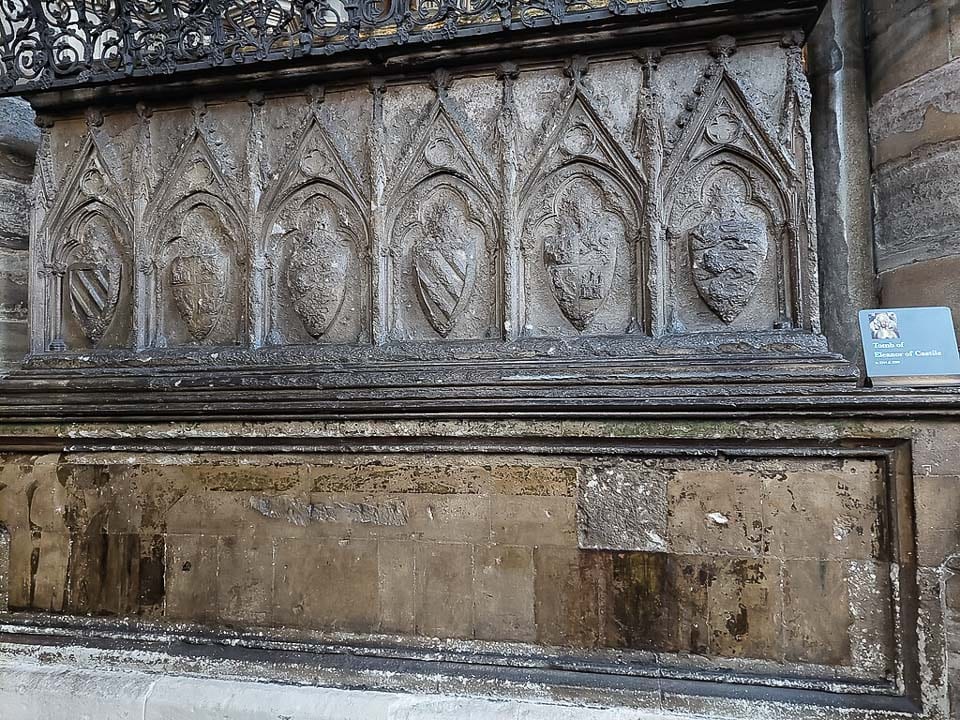
King Edward III and Queen Philippa of Hainault
Burial: St. Edward’s Chapel
Edward III was King of England from 1327 to 1377. As king, much of his time was devoted to warfare and making the Kingdom of England a military power, but he was also known for reforming Parliament and passing important legislation.
After dying of a stroke, Edward III was buried at Westminster Abbey in St. Edward’s Chapel. His Purbeck marble tomb features a gilt bronze effigy wearing his coronation robes and holding the handles of two sceptres (the rest broke off). The top of the tomb has niches holding small gilt angels, the sides have bronze statuettes of his children (only 6 out of 12 remain), and the base has shields. The tomb is covered by an elegant and intricately carved wooden canopy.
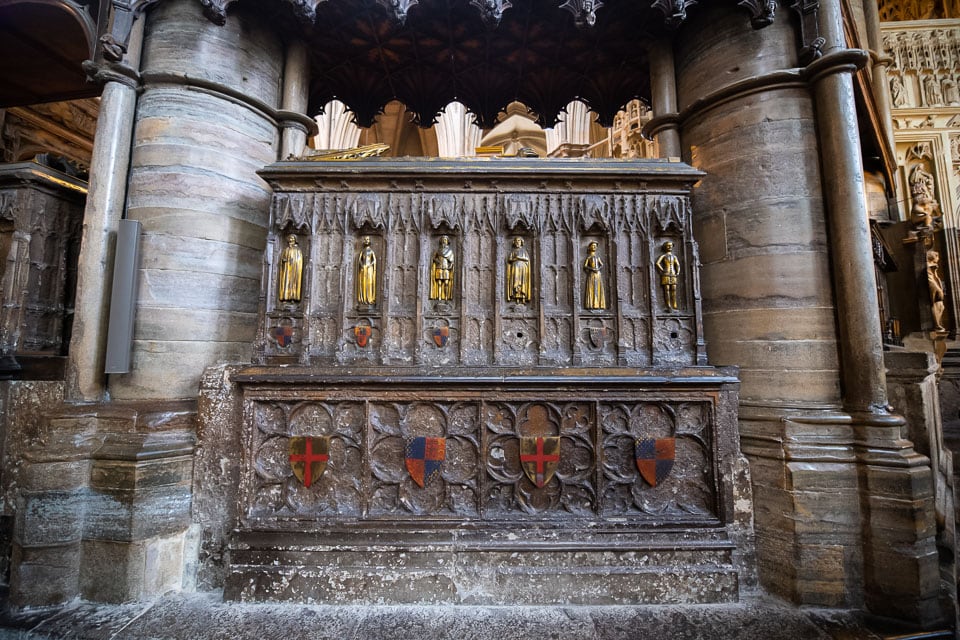
Edward’s wife, Philippa of Hainault, is also buried in the Confessor’s chapel. Her tomb has an alabaster effigy, but many of the other decorations have disappeared or been damaged. What remains are some shields of arms and two statuettes (weepers).
King Richard II and Anne of Bohemia
Burial: St. Edward’s Chapel
King Richard II succeeded his grandfather Edward III to become king in 1377 at age 10. Richard faced many challenges during his reign, including the Hundred Years’ War and the Peasants’ Revolt of 1381. Overall, he was not a successful king and was eventually deposed and imprisoned by his cousin Henry Bolingbroke, who crowned himself Henry IV.
Richard II was originally buried in King’s Langley Priory, but was moved to Westminster Abbey in 1413 by Henry V. Richard’s wife Anne was already laid to rest here in the tomb Richard had prepared for them. Theirs was the first double royal tomb in Westminster Abbey. The tomb has gilt bronze effigies of Richard and Anne, who were originally depicted holding hands until they broke off.
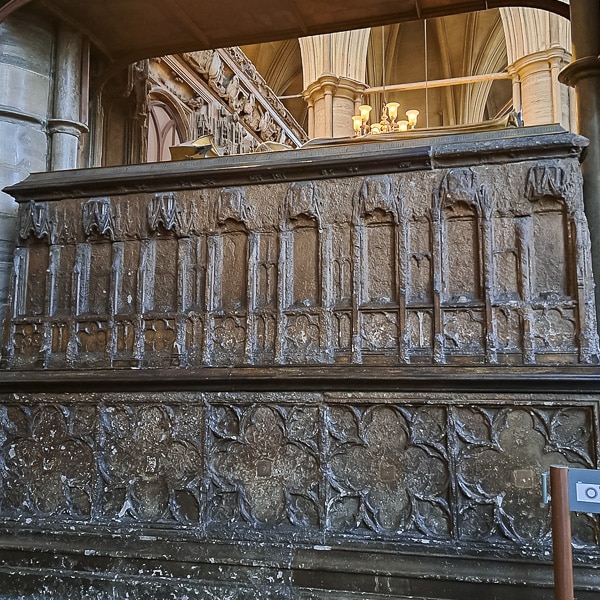
King Henry V and Queen Catherine de Valois
Burial: St. Edward’s Chapel (Henry V Chantry)
Henry V took the throne in 1413 and was King of England until he died in 1422 at the age of 35. Under his reign, England became one of the strongest military powers in Europe and had successful conquests in France during the Hundred Years’ War.
Henry V was buried in Westminster Abbey in a chantry chapel near Edward the Confessor. His tomb originally had an effigy made of oak and silver, but all the silver pieces were stolen. A new head, hands, and crown for the effigy were made in polyester resin in 1971. The chantry above the tomb is quite beautiful with carved figures of saints and kings. There are also sculptures depicting Henry’s coronation and him riding his horse into battle.
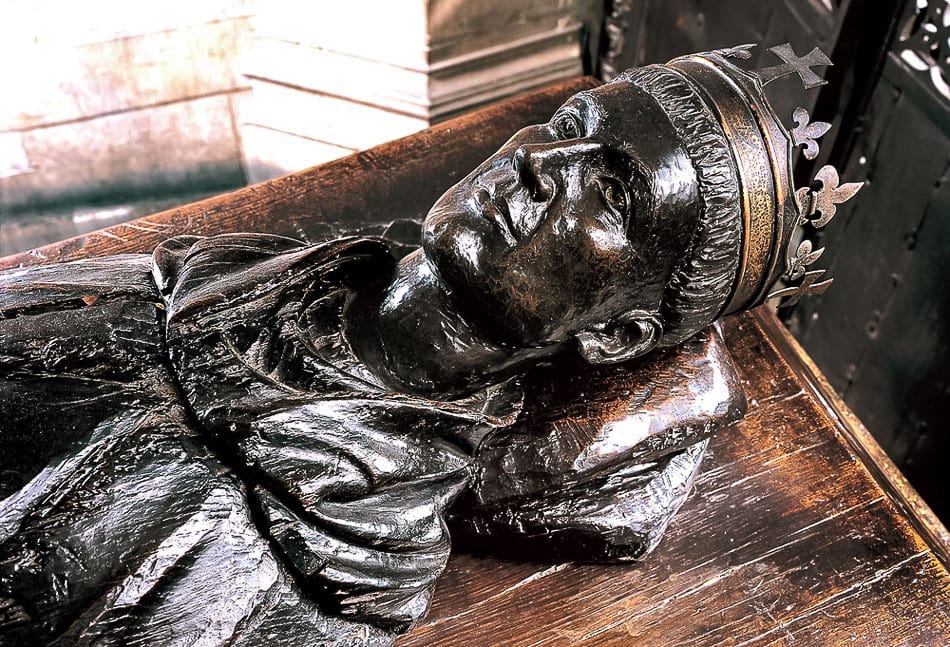
Henry’s wife, Catherine de Valois, is buried under an altar in Henry V’s chantry. Her tomb is decorated with three badges of Henry V (a swan, an antelope, and a beacon) and a coat of arms.
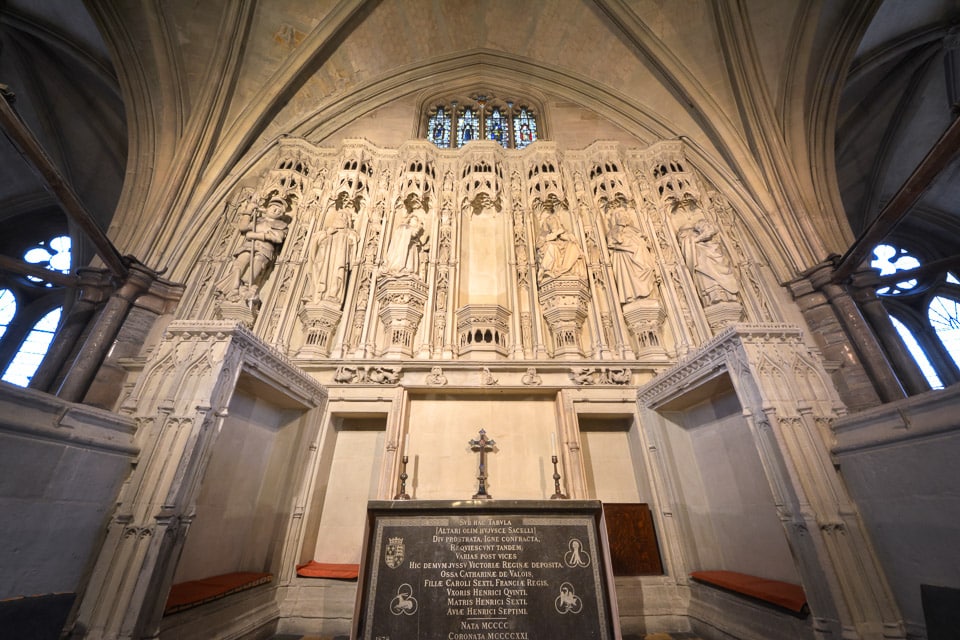
King Henry VII and Queen Elizabeth of York
Burial: Lady Chapel
Henry VII seized the throne from Richard III in 1485, becoming the first monarch of the House of Tudor. He greatly contributed to Westminster Abbey, building the magnificent Lady Chapel where he is buried.
Henry VII and Queen Elizabeth of York were the first monarchs buried in Westminster Abbey in a vault under the floor rather than an above-ground chest. However, a stunning marble and bronze tomb was erected above the vault as a memorial to the couple.
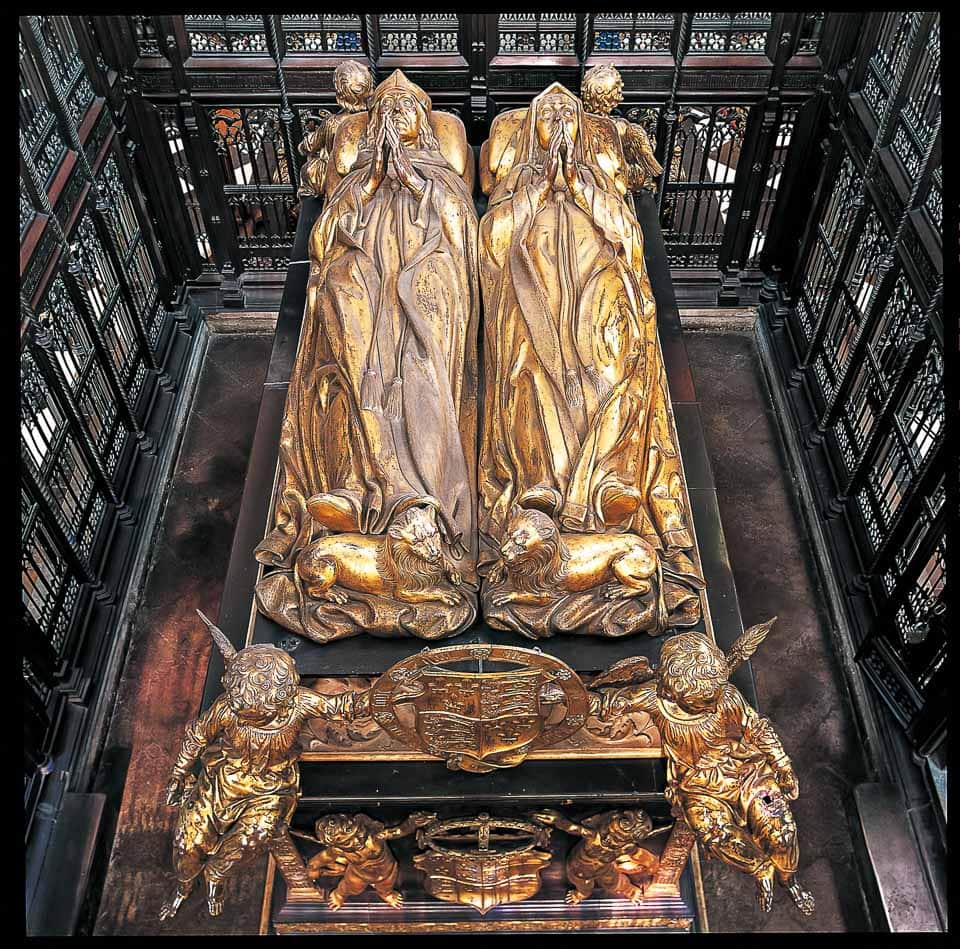
The black marble tomb of Henry VII and Elizabeth of York was designed in Renaissance style and is decorated with copper gilt medallions of patron saints, coats of arms held by cherubs and angels, and a carved frieze. Laying on top are gilt bronze effigies of the couple with their hands held in prayer and lions at their feet. The monument is surrounded by an intricately carved grille with niches holding statues.
The fine condition of Henry and Elizabeth’s tomb and its gorgeous decorations make it one of the most beautiful royal tombs in Westminster Abbey.
Mary, Queen of Scots
Burial: Lady Chapel
Mary, Queen of Scots was only 6 days old when she inherited the throne in 1542. Following an uprising, she was imprisoned and forced to abdicate in 1567 in favour of her son James. After escaping and trying unsuccessfully to regain the throne, she fled to England. Here Mary was perceived as a threat by her cousin Queen Elizabeth I, who then had Mary confined and later beheaded for plotting to assassinate her.
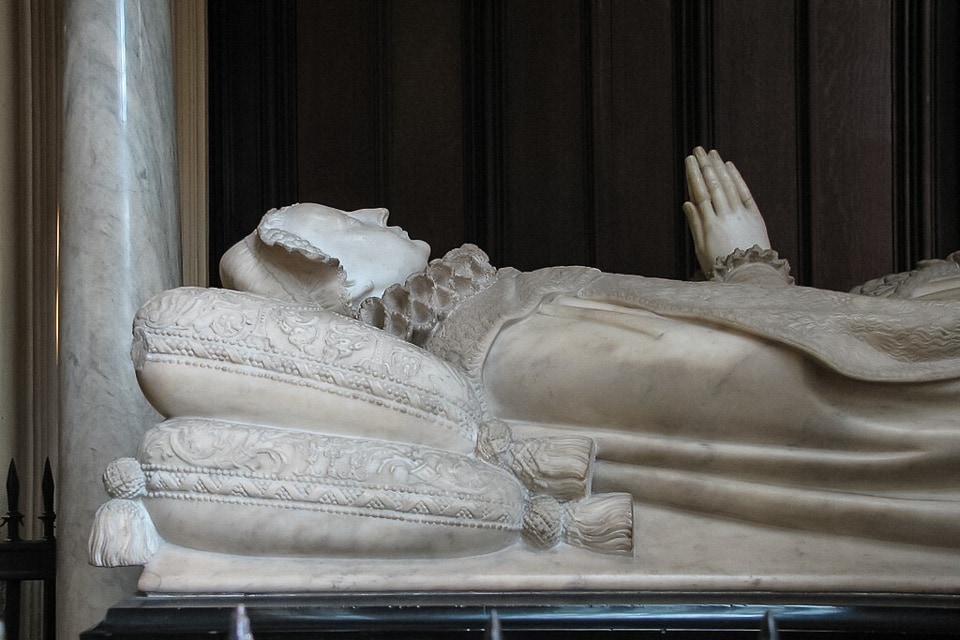
Mary was originally buried at Peterborough Cathedral but was reinterred at Westminster Abbey in 1612 by order of her son James I. Mary’s imposing marble tomb is in the south aisle of the Lady Chapel and features a white marble effigy under an ornate canopy decorated with sculpted thistle, coats of arms, and obelisks. At the feet of the effigy is a crowned Scottish lion.
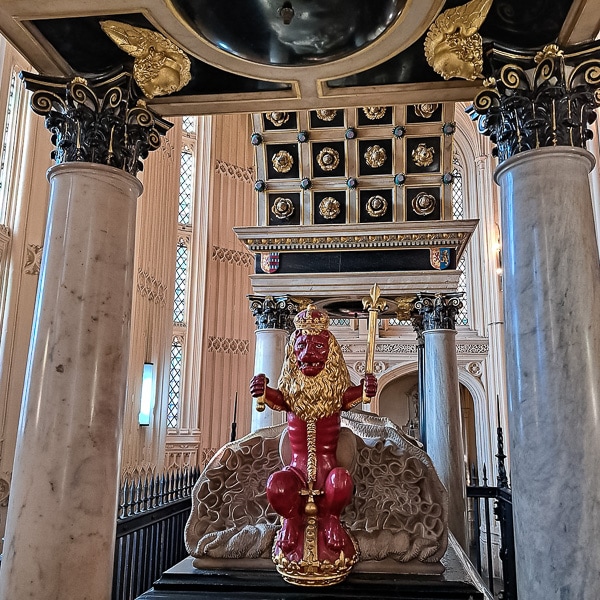
King James I and Queen Anne of Denmark
Burial: Lady Chapel
James I was the son of Mary, Queen of Scots and served as King of Scotland (as James VI) from 1567 and King of England and Ireland from 1603-1625. He advocated for a single parliament for England and Scotland since they were both under his rule, but they remained sovereign states.
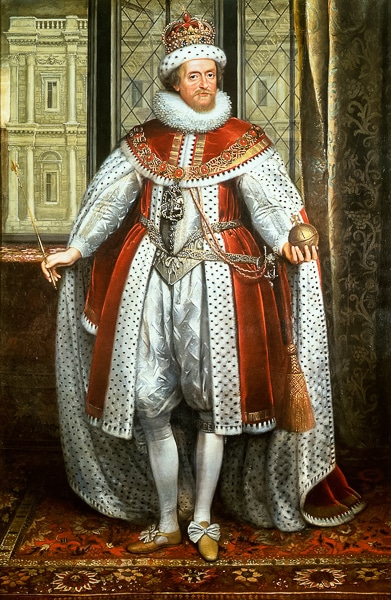
James I was laid to rest in the vault beneath Henry VII’s monument. No monument was erected for James, but there is an inscription at the east end of Henry VII’s tomb grille to mark his grave.
Queen Anne of Denmark’s grave in the Lady Chapel also has no monument and is instead marked by a stone.
Queen Elizabeth I and Queen Mary I
Burial: Lady Chapel
Half-sisters Queen Mary I and Queen Elizabeth I had successive reigns as Queen of England and Ireland (Mary from 1553-1558 and Elizabeth from 1558-1603).
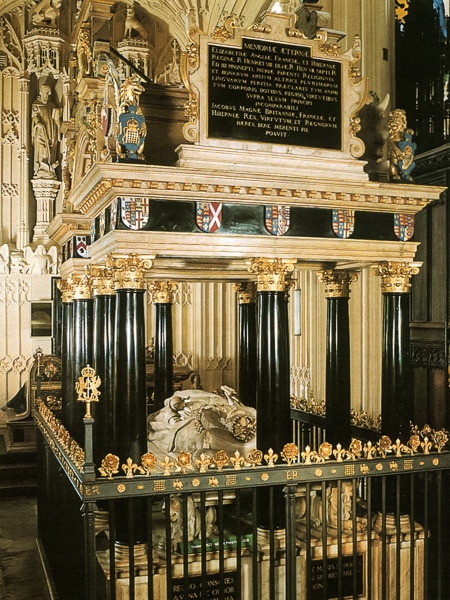
Mary I is remembered for her efforts to reverse the English Reformation and restore Roman Catholicism in England, while also persecuting her Protestant opponents (hence her nickname “Bloody Mary”). Elizabeth I was the last monarch of the House of Tudor and her establishment of an English Protestant church is credited with helping to shape a national identity. Her long reign also brought stability to the kingdom.
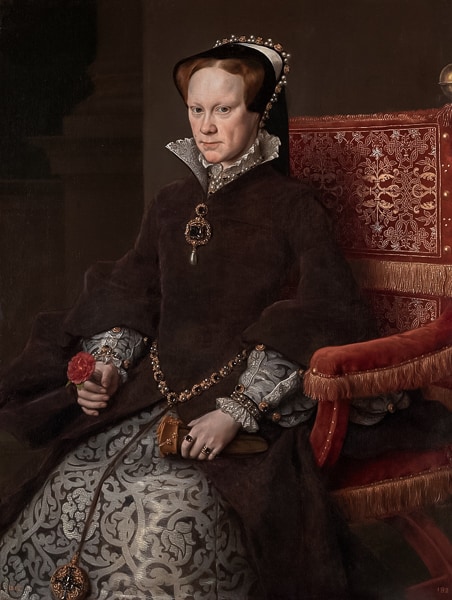
Mary and Elizabeth are buried together in a vault in the north aisle of the Lady Chapel. The white marble monument above the grave has an effigy of Elizabeth only, but Mary is mentioned in an inscription. Elizabeth’s sculpted effigy features modern additions of a crown, sceptre, and a ruffled collar. At each corner of the effigy are four carved lions. A pillared canopy covers the tomb and a decorative railing surrounds it.
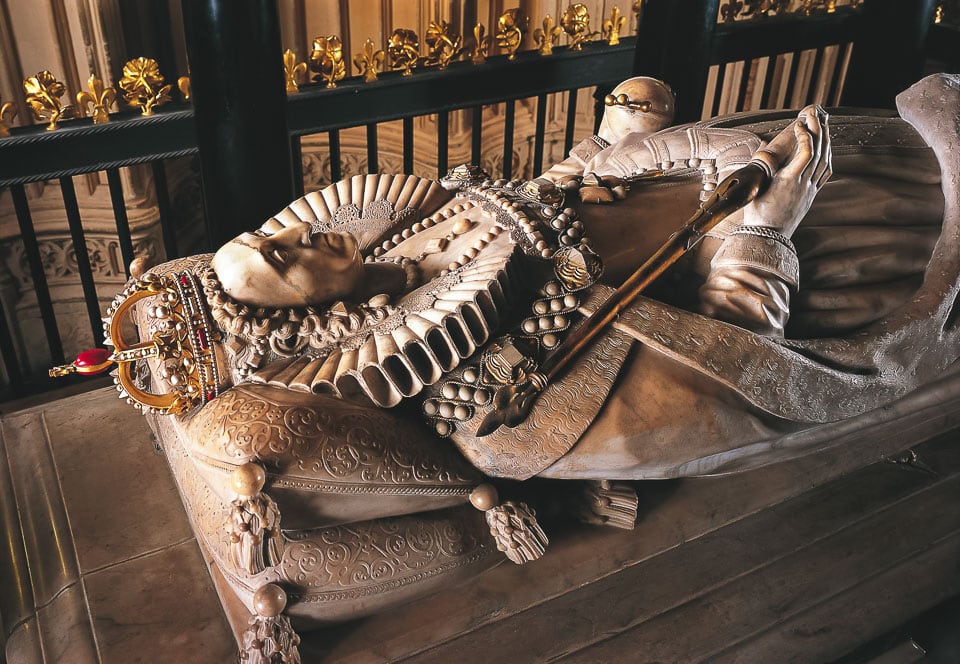
King Edward VI
Burial: Lady Chapel
Edward VI became king in 1547 when he was 9 years old, succeeding his father Henry VIII. Since he was a minor for the entirety of his reign (he died at age 15), a regency council was established to govern. During his time on the throne, the Church of England became markedly Protestant.
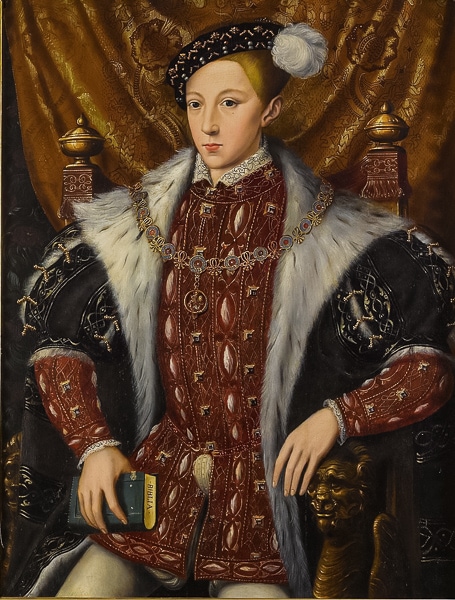
Edward VI was buried beneath the original altar of the Lady Chapel. His grave was unmarked until 1966 when Christ’s Hospital school laid a black inscribed stone in the floor to honour its founder.
King George II and Queen Caroline
Burial: Lady Chapel
George II was King of Great Britain and Ireland from 1727 until his death in 1760. He didn’t have much input on domestic policy, as this was largely controlled by Parliament, but British interests expanded across the world during his reign.
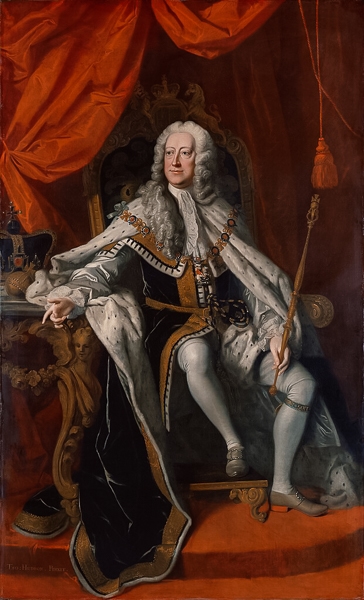
George II and his wife Caroline were buried in the Hanoverian vault below the central aisle of the Lady Chapel. There’s no monument, only stones on the floor marking the grave location. Due to a lack of space, George II was the last of the monarchs buried in Westminster Abbey. Succeeding monarchs were buried at Windsor Castle, St. George’s Chapel, or in the Royal Mausoleum at Frogmore.
More Royals Buried in Westminster Abbey
Here are a few more monarchs and other royals buried in Westminster Abbey.
- King Charles II (1630-1685)- buried in the Stuart vault under the south aisle of Lady Chapel
- Queen Anne (1665-1714)- buried in the Stuart vault
- Prince George of Denmark (1653-1708)- buried in the Stuart vault
- Queen Mary II (1662-1694)- buried in the Stuart vault
- King William III (1650-1702)- buried in the Stuart vault
- Anne Neville, wife of Richard III (1456-1485)- buried on the southern side of the High Altar, in front of the seats for the priests
- Edward V (1470-1483) and Richard Duke of York (1473-1483)- bones presumed to belong to the brothers were interred in a marble urn in the north aisle of the Lady Chapel
- Henry Frederick, Prince of Wales (1594-1612)- buried in the south aisle of the Lady Chapel in the vault of his grandmother Mary Queen of Scots
- Anne of Cleves, 4th wife of Henry VIII (1515-1557)- buried in a tomb on the south side of the High Altar
- John of Eltham, Earl of Cornwall (1316-1336)- buried in an alabaster tomb in the Chapel of St. Edmund
- Henry Frederick, Duke of Cumberland (1745-1790)- buried in the Hanoverian vault below the central aisle of the Lady Chapel
- Prince Eugene of Savoy (1692-1712)- buried in the Duke of Ormond’s vault at the east end of the Lady Chapel
- William Duke of Cumberland (1721-1765)- buried with family members in the Hanoverian vault in the Lady Chapel
- Elizabeth Stuart, Queen of Bohemia (1596-1662)- buried under the south aisle of the Lady Chapel
- Frederick Louis, Prince of Wales (1707-1751)- buried in the Hanoverian vault in the Lady Chapel
- Edmund, Earl of Lancaster (1245-1296) and Aveline de Forz (1259-1274)- buried in a tomb in St. Edward’s Chapel on the north side of the High Altar
- Princess Mary of Orange (1631-1660)- buried in a vault under the south aisle of the Lady Chapel
- Prince Rupert of the Rhine (1619-1682)- buried with his mother in a vault on the south side of the Lady Chapel
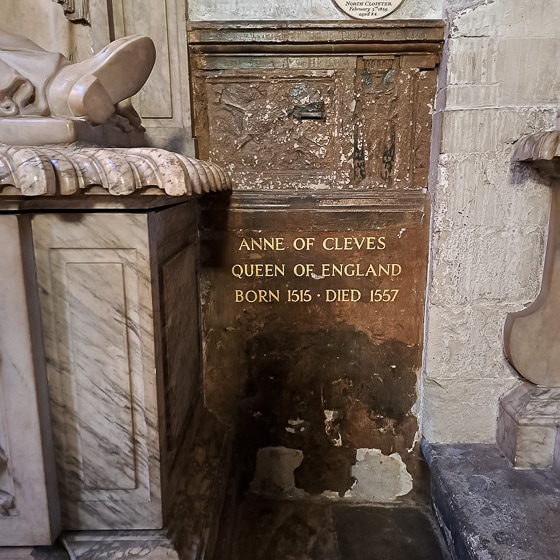
Final Thoughts About the Westminster Abbey Royal Tombs
Viewing the royal tombs in Westminster Abbey is one of the highlights of visiting this historic sanctuary. Even if you’re not into the monarchy, or familiar with the royals buried in Westminster Abbey, it’s still interesting to see the artistry of the tombs and memorials.
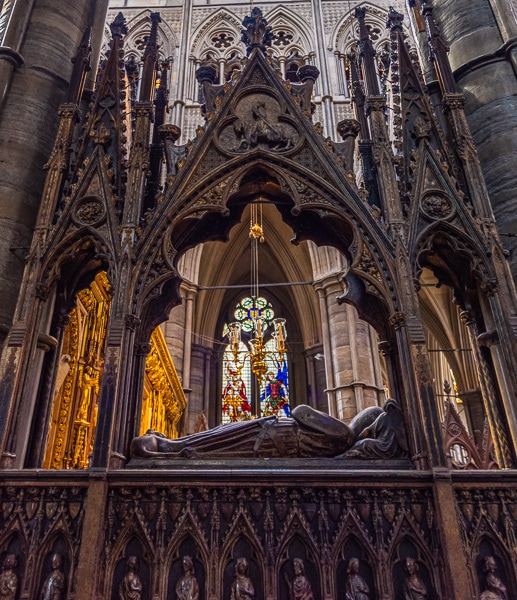
Practical Information for Visiting Westminster Abbey
Location: Westminster Abbey is located in London at 20 Dean’s Yard.
Hours: Westminster Abbey is open Monday to Friday from 9:30 am- 4:30 pm (last entry 3:30 pm), Saturday from 9:00 am- 4:00 pm (last entry 3:00 pm), and Sunday for services. Confirm current hours here.
Admission Fees: Yes
Tours: A multimedia guide is included in the price of admission so you can do a self-guided tour of the abbey at your own pace.
- Guided tours, led by the abbey’s vergers, are available for an extra fee and let you see parts of the abbey not accessible to general visitors.
- Tours by private companies and guides can be booked online here.
Buy Tickets: Entrance tickets can be bought on the Westminster Abbey website (non-refundable) or online here (refundable).
Accommodations in London
If you’re planning to visit Westminster Abbey and need accommodations, here is a list of hotels in London. Please consider booking your London accommodations through the included link. It costs nothing extra and helps support this website.
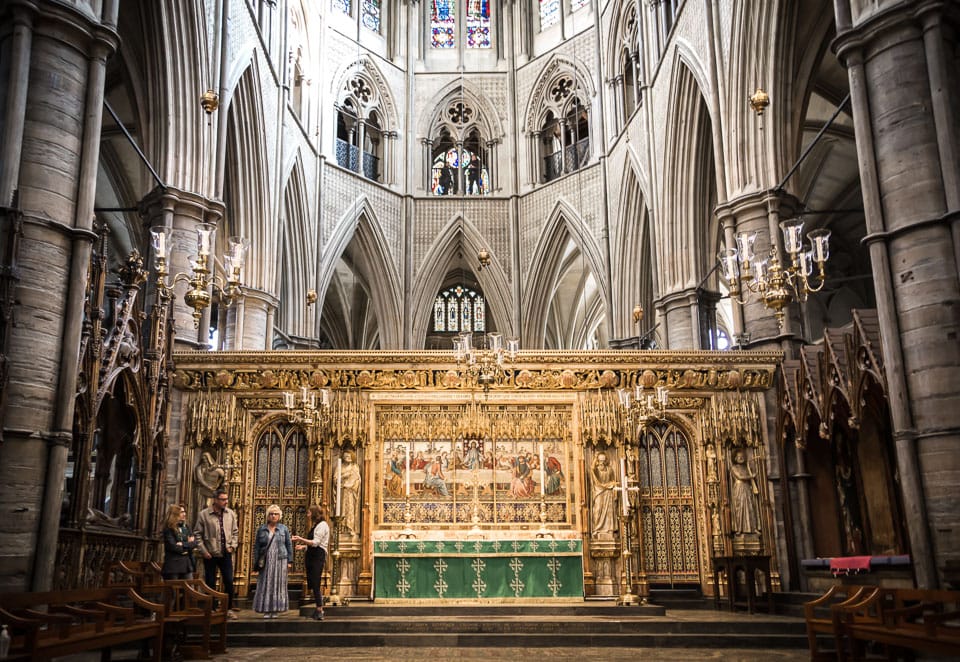
More Burial Places in the U.K. and Overseas Territories
- Famous People Buried in Westminster Abbey- The Legendary Burials at Westminster Abbey
- Highgate Cemetery Burials- Famous Graves in Highgate Cemetery
- The Magnificent Seven Cemeteries- Victorian Cemeteries in London
- Shakespeare’s Grave and Funerary Monument- Discover Shakespeare’s Burial Place in Stratford-upon-Avon
- Grytviken Cemetery- Site of Ernest Shackleton’s Grave

